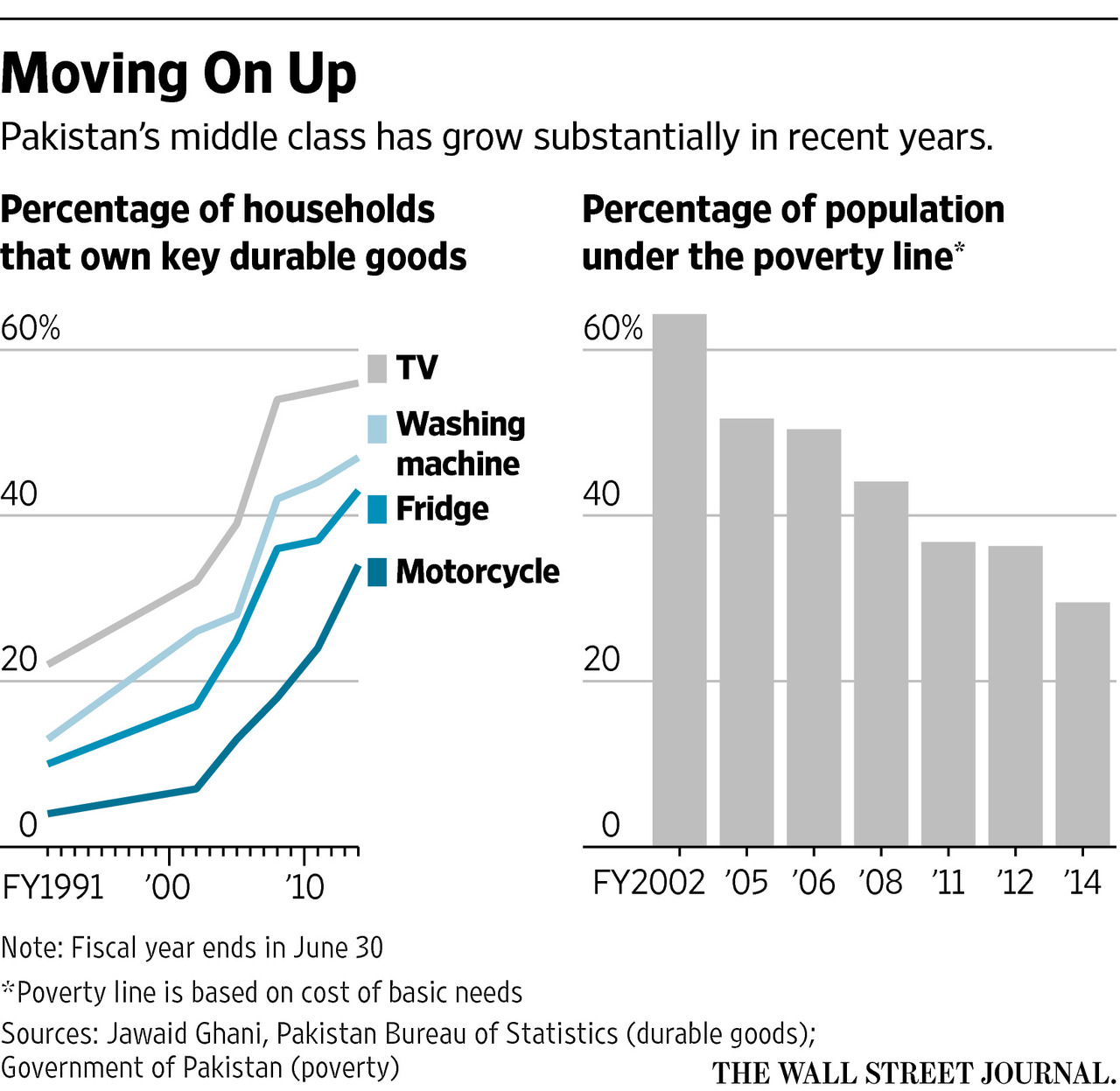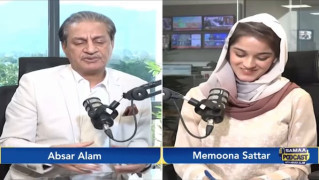Sohail Shuja
Chief Minister (5k+ posts)
While on my prowl to hunt for something hilarious on the internet, I stumbled upon a tweet from Maryam Nawaz Sharif, which stunned me at the first glance and after reading the referenced article, I gave her full points to cheer me up.... now lets see the tweet here
Now look at the statistics which are being given in the WSJ article, twisting the facts to their bones.

Source: Wall Street Journal (can be accessed @: https://www.wsj.com/articles/pakistans-middle-class-soars-as-stability-returns-1485945001)
Now every person with functioning eyes and an average IQ can understand that the poverty decline started from 2002 onwards, where it was skyrocketing at above 60% and by 2008 it was brought down to a little above than 40%. So that makes up for a 20% decline in 6 years.
However, by looking at what Maryam Nawaz is tweeting about, in 2017 are the statistics updated until 2014 (3 years old), which mentions that the poverty line was brought down to 29% in 2014. Which is not true, but still, for a rough comparison with Musharraf's era, the progress here is only 11% decline in poverty, spanning over 8 years.
Now here lies the real point.....
For some reasons, I was looking for the latest poverty statistics of Pakistan some days back, therefore, the figures suddenly flashed back in my mind while reading this article and I couldn't help my laugh....
In 2016, it was widely published in Pakistani press and media that the poverty percentage of population living under poverty line is 39% as reported by UNDP (now how credible is that???)

Source: UNDP MPI Brief 2016 (can be accessed @ http://www.pk.undp.org/content/pakistan/en/home/presscenter/pressreleases/2016/06/20/pakistan-s-new-poverty-index-reveals-that-4-out-of-10-pakistanis-live-in-multidimensional-poverty.html)
Now comparing the statistics given by UNDP and the article of WSJ, written by Mr.Saeed Shah, it is interesting to note the disparities and how these statistics are used to create a mirage of development under poorly performing governments of Pakistan. The real notion here indicates only a single figure decline in the past eight years of democracy.
Poverty is not only considered in a single dimension of wealth alone, as it creates a blind spot in analysis. Consider a population of 10 people, where one has Rs 100 with him and the rest 9 have only Rs 1 each. Now if we take a straitjacket approach to average out the wealth of each person, it will come at about Rs 11/person, which is not true. Only one person is keeping more than 90% of the wealth here.
Keeping this in view, the modern statisticians allowed other dimensions to be included for consideration in order to get the clearer picture of the situation. This included things like access to health facilities, education and shelter etc. The significance of these parameters describe the pattern of wealth distribution in a population. Now if we consider the given case above in this scenario, it will definitely show that only 1 out of 9 people has adequate access to health, shelter, education and clean drinking water etc. The real image is thus revealed, much clearly. This approach is known as Multi-dimensional Poverty Index or MPI ( I wonder if WSJ even know an iota of it)
I wonder why a credible source like Wall Street Journal is projecting misleading statistics here? even if we dig up to the statistics shown by them in their article, it appears that the rate of decline of poverty was speedier during the 2002-2008 era. I wonder how the analyst has concluded that the decline in poverty is associated with the policies of the governments succeeding 2008? On the other hand, how does the sale of luxury consumer items like refrigerators and washing machines etc are even remotely connected with the human development index? if the wealthy is getting wealthier, then he will buy two refrigerators instead of one. So that describes the increase in the sale of these items. However, the real development is projected in the facts that how many people have got access to proper healthcare? how many are living under proper shelter and have access to clean drinking water and appropriate food? how many children are going to school and have access to quality education?
In purview of the recent developments. it appears that the Government is trying hard to extract something out of thin air to project as their development, in disguise. Whereby, even the credible sources like Wall Street Journal also appear to be lowering their credibility, though they already raised many brows worldwide during the 2008-10 global economic crisis, where their analysts were projecting figures that were unlikely to prevail and were grossly misleading for the investors.
Perhaps, it is one of the classic example where we can safely say that "This is how these Patwari Articles Get published" in magazines like WSJ because no one other than Patwaris are paying them these days to publish articles like these. It is understandable that after WSJ lost its credibility for the real investors back in 2008-10, they are now dependent on these Patwaris to make up articles like that.
Although, I am open for any ideas and/or comments which can correct me in this respect if I am perceiving anything in an improbable perspective.
Now look at the statistics which are being given in the WSJ article, twisting the facts to their bones.

Source: Wall Street Journal (can be accessed @: https://www.wsj.com/articles/pakistans-middle-class-soars-as-stability-returns-1485945001)
Now every person with functioning eyes and an average IQ can understand that the poverty decline started from 2002 onwards, where it was skyrocketing at above 60% and by 2008 it was brought down to a little above than 40%. So that makes up for a 20% decline in 6 years.
However, by looking at what Maryam Nawaz is tweeting about, in 2017 are the statistics updated until 2014 (3 years old), which mentions that the poverty line was brought down to 29% in 2014. Which is not true, but still, for a rough comparison with Musharraf's era, the progress here is only 11% decline in poverty, spanning over 8 years.
Now here lies the real point.....
For some reasons, I was looking for the latest poverty statistics of Pakistan some days back, therefore, the figures suddenly flashed back in my mind while reading this article and I couldn't help my laugh....
In 2016, it was widely published in Pakistani press and media that the poverty percentage of population living under poverty line is 39% as reported by UNDP (now how credible is that???)

Source: UNDP MPI Brief 2016 (can be accessed @ http://www.pk.undp.org/content/pakistan/en/home/presscenter/pressreleases/2016/06/20/pakistan-s-new-poverty-index-reveals-that-4-out-of-10-pakistanis-live-in-multidimensional-poverty.html)
Now comparing the statistics given by UNDP and the article of WSJ, written by Mr.Saeed Shah, it is interesting to note the disparities and how these statistics are used to create a mirage of development under poorly performing governments of Pakistan. The real notion here indicates only a single figure decline in the past eight years of democracy.
Poverty is not only considered in a single dimension of wealth alone, as it creates a blind spot in analysis. Consider a population of 10 people, where one has Rs 100 with him and the rest 9 have only Rs 1 each. Now if we take a straitjacket approach to average out the wealth of each person, it will come at about Rs 11/person, which is not true. Only one person is keeping more than 90% of the wealth here.
Keeping this in view, the modern statisticians allowed other dimensions to be included for consideration in order to get the clearer picture of the situation. This included things like access to health facilities, education and shelter etc. The significance of these parameters describe the pattern of wealth distribution in a population. Now if we consider the given case above in this scenario, it will definitely show that only 1 out of 9 people has adequate access to health, shelter, education and clean drinking water etc. The real image is thus revealed, much clearly. This approach is known as Multi-dimensional Poverty Index or MPI ( I wonder if WSJ even know an iota of it)
I wonder why a credible source like Wall Street Journal is projecting misleading statistics here? even if we dig up to the statistics shown by them in their article, it appears that the rate of decline of poverty was speedier during the 2002-2008 era. I wonder how the analyst has concluded that the decline in poverty is associated with the policies of the governments succeeding 2008? On the other hand, how does the sale of luxury consumer items like refrigerators and washing machines etc are even remotely connected with the human development index? if the wealthy is getting wealthier, then he will buy two refrigerators instead of one. So that describes the increase in the sale of these items. However, the real development is projected in the facts that how many people have got access to proper healthcare? how many are living under proper shelter and have access to clean drinking water and appropriate food? how many children are going to school and have access to quality education?
In purview of the recent developments. it appears that the Government is trying hard to extract something out of thin air to project as their development, in disguise. Whereby, even the credible sources like Wall Street Journal also appear to be lowering their credibility, though they already raised many brows worldwide during the 2008-10 global economic crisis, where their analysts were projecting figures that were unlikely to prevail and were grossly misleading for the investors.
Perhaps, it is one of the classic example where we can safely say that "This is how these Patwari Articles Get published" in magazines like WSJ because no one other than Patwaris are paying them these days to publish articles like these. It is understandable that after WSJ lost its credibility for the real investors back in 2008-10, they are now dependent on these Patwaris to make up articles like that.
Although, I am open for any ideas and/or comments which can correct me in this respect if I am perceiving anything in an improbable perspective.
Last edited:

























